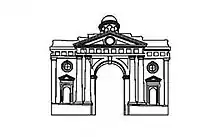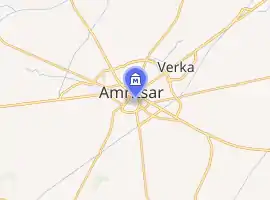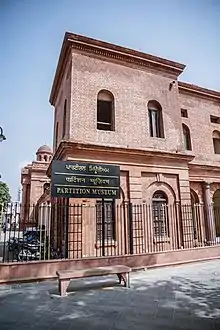Partition Museum
The Partition Museum is a public museum located in the town hall in Amritsar, India.[1] The museum aims to become the central repository of stories, materials, and documents related to the post-partition riots that followed the division of British India into two independent countries: India and Pakistan.[2] The museum was inaugurated on 25 August 2017.[3]
 Partition museum logo | |

| |
| Established | 25 August 2017 |
|---|---|
| Location | Amritsar, Punjab, India |
| Coordinates | 31.6258°N 74.8787°E |
| Collections | 1947 archives, oral histories |
| Founder | The Arts and Cultural Heritage Trust (TAACHT) |
| Chairperson | Kishwar Desai |
| Nearest parking | Limited |
| Website | https://www.partitionmuseum.org/ |

History
In 1947, British India was divided into India and Pakistan. The partition lines, drawn on a map by the British lawyer Cyril Radcliffe, divided the states of Punjab into West Punjab and East Punjab on the basis of religion. As a result, millions of people found themselves on the wrong side of the border overnight. According to various estimates, more than 800,000 Muslims, Hindus, and Sikhs were killed in the riots that followed the partition between August 1947 to January 1948. Additionally, more than 1,400,000 people became refugees.
The government of Punjab founded this museum with The Arts and Cultural Heritage Trust of the United Kingdom as a way to memorialize those who were affected by the partition.[4]
References
- Kaur, Usmeet (25 October 2016). "Country's first Partition Museum: A story of pain and resurgence". Hindustan Times. Retrieved 6 January 2019.
- "Partition Museum curates online events to allow visitors to sneak a peek into the pages of history". The Tribune. 12 September 2020. Retrieved 13 September 2020.
- Menon, Parvathi (3 December 2015). "Amritsar's Partition museum to relive a generation's sacrifices". The Hindu. ISSN 0971-751X. Retrieved 6 January 2019.
- "Partition Museum, India". The Partition Museum. Retrieved 6 January 2019.